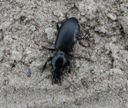Broscus
Broscus
Classification
- Phylum: Arthropoda
- Subphylum: Hexapoda
- Class: Insecta
- Order: Coleoptera
- Suborder: Adephaga
- Family: Carabidae
- Subfamily: Broscinae
- Genus: Broscus
Pronunciation
How to pronounce Broscus: /ˈbrɔs.kus/
These audio files are automatically generated. While they are not always 100% accurate, they are a good starting point.
Images






Summary
Broscus is a genus of ground beetles known for its adaptability and varied species richness across the Palaearctic and adventive populations in North America. They play an essential role in ecosystems by controlling pest populations, and their various species exhibit distinct adaptations to their habitats.
Physical Characteristics
Ground beetles in the genus Broscus are typically elongated and can exhibit a variety of colors, often showing a metallic sheen. They have well-defined pronota and a slender abdomen, adapted for their ground-dwelling lifestyle.
Identification Tips
Identifying Broscus involves observing the unique coloration patterns, the shape of the pronota, and the specific body proportions, which vary between species. The presence of certain morphological characteristics such as the structure of the elytra can also help in species identification.
Habitat
Broscus species are commonly found in a variety of habitats, including forests, grasslands, and areas with loose soil where they can burrow. They are often associated with damp environments.
Distribution
Primarily distributed across the Palaearctic region, Broscus species are adventive in North America, particularly in the Atlantic Canada region. The notable presence of over 20 species suggests a wide range of local adaptations across their native areas.
Diet
As carnivorous beetles, Broscus primarily feed on other insects and invertebrates, aiding in controlling pest populations in their ecosystems.
Life Cycle
Broscus undergo a complete metamorphosis, consisting of egg, larval, pupal, and adult stages. The lifecycle duration can vary depending on environmental conditions and species.
Reproduction
Broscus species reproduce sexually, and females lay eggs in the soil or under debris. Larvae emerge and develop by feeding on organic matter and small invertebrates.
Predators
Potential predators of Broscus beetles include birds, mammals, and larger predatory insects, as they play a role in the food web.
Ecosystem Role
Broscus contributes to soil health and pest control through their predatory behavior. They are indicators of ecological balance within their habitats.
Collecting Methods
- Hand collection in suitable habitats
- Pitfall traps for attracting and capturing specimens
Preservation Methods
- Pinning specimens
- Preserving in alcohol for softer-bodied species
Evolution
The evolutionary relationships within Broscus indicate adaptation to various environments in the Palaearctic, suggesting a history of diversification linked to climate and habitat changes.
Similar Taxa
Misconceptions
Some may confuse Broscus with other ground beetles due to their similar appearance, but specific morphological identifiers can differentiate them.
Tags
- beetles
- ground beetles
- Broscus
- carabidae
- ecology
- entomology